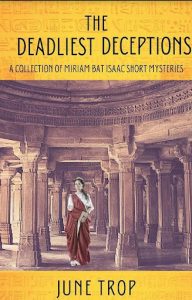My Life of Crime
My Life of Crime
 My life of crime began in fifth grade when the girl sitting next to me was reading a Nancy Drew mystery. After borrowing hers, I swallowed them all up, one book after another of Nancy Drew, the Dana Girls, and the Hardy Boys. Later, I graduated to Agatha Christie, starting with her singularly spectacular The Murder of Roger Ackroyd. I remember my hands trembling like blossoms in a breeze when the murderer was revealed. And now, after having read thousands of mysteries, I still agree with the British Crime Writers’ Association when they named The Murder of Roger Ackroyd as the best crime novel ever written.
My life of crime began in fifth grade when the girl sitting next to me was reading a Nancy Drew mystery. After borrowing hers, I swallowed them all up, one book after another of Nancy Drew, the Dana Girls, and the Hardy Boys. Later, I graduated to Agatha Christie, starting with her singularly spectacular The Murder of Roger Ackroyd. I remember my hands trembling like blossoms in a breeze when the murderer was revealed. And now, after having read thousands of mysteries, I still agree with the British Crime Writers’ Association when they named The Murder of Roger Ackroyd as the best crime novel ever written.
Around that time, I also began to read the Sherlock Holmes stories. By the time I’d read all of them, I knew what I wanted to be. I’d honed my observation skills as Holmes had instructed Watson and went about the neighborhood looking for crimes to solve, secrets to unravel, puzzles to explain, and codes to decipher. But alas, to my dismay, no mysteries materialized, certainly not as they had for Nancy, Hercule, and Sherlock.
So, what was I going to do with my life? Instead of a detective, I became a science teacher, the closest I could get to uncovering mysteries. And so, years later, in a graduate course on the historical development of concepts in chemistry, I encountered the model of my future protagonist. The professor had assigned a paper on a historically significant concept. I’d studied chemistry for years but only from the perspective of contemporary knowledge. So, for all my efforts, I could not think of a topic to write about. And as the days spun into weeks, the passage of time swung like a blade over my head.
In desperation, I haunted the stacks of the university library with the hope that an idea would strike me. And that’s exactly what happened. As I looked teary-eyed toward the heavens for an inspiration, I bumped into a tottering shelf of dusty books on the history of chemistry. And wouldn’t you know it, the thickest tome of all fell on my toe and opened to a page about Maria Hebrea. Who on Earth was she? Only someone who’d held her place for 1500 years as the most celebrated woman of the Western World for her contributions to the study of alchemy! Although I wouldn’t begin writing the Miriam bat Isaac Mystery Series for almost thirty years and model my protagonist after Maria Hebrea, I committed to the topic of alchemy as if a veil of cobwebs had fallen away.
By the time I was ready to retire, I was a professor of science teacher education accustomed to writing for an academic audience. I’d enjoyed the writing aspect of my career but longed to exercise my imagination, use lyrical language and the active voice, and oh yes, stretch the truth, even if only a little. And I still yearned for that life of crime I’d left behind.
So, I resurrected my memory of Maria Hebrea. Actually, I’d never stopped thinking about her. Whenever I’d stop for a red light or wait my turn in a checkout line, I’d wonder what it was like for her to elbow through a crowd along the main boulevard of first-century CE Alexandria. Or I’d pretend I was Maria, feeling the morning sun on my back as I made my way to the agora. Perhaps she had to elude a camel caravan, curtained litter, or groaning oxcart or zigzag around a drove of prigs or a platoon of soldiers.
She had to have been intelligent, of course, but she must have been intrepid as well. The emperor, afraid that the alchemists would, in synthesizing gold, corrupt his currency, and overthrow the empire, decreed that its practice was a capital offense. Still, Maria Hebrea, like Nancy Drew, risked her life for her craft but guarded the secrecy of her life.
Which meant that with Maria Hebrea as the model for my protagonist, I was free to invent a life for her. So, I gave my Miriam a twin brother, a fierce athlete who’d become a famous gladiator; a tyrannical father, who’d coerce her into choosing duty over desire; and a servant girl five years her senior. Phoebe would become her stubbornly girlish best friend, co-conspirator, and faithful keeper of secrets despite her love of gossip and flair for theatrics.
So, it’s no surprise that I came to write mysteries. I write to escape with others into the perilous adventures of Miriam bat Isaac and her deputy Phoebe. My sixth and most recent book in the series, The Deadliest Deceptions, is a collection of nine short mysteries ranging from cozy to noir. They take readers into the world of scoundrels, whether in the splendid homes of the Palace Quarter or the sleazy inns of the city’s underbelly. Aside from making their blood flow faster as they enter that exotic world of possibilities, I hope readers will see that justice can be found even outside the boundaries of the law and that regardless of our time and place, race or creed, we all face the same problems.
—
June Trop has focused on storytelling her entire professional life. As a professor of teacher education, she focused her research on the practical knowledge teachers construct and communicate through storytelling. Now associate professor emerita, she writes the Miriam bat Isaac Mystery Series, a collection of novels and short stories set in first-century CE Roman Alexandria.
Find out more about June on her website https://www.junetrop.com/
THE DEADLIEST DECEPTIONS
 Enter the world of first-century CE Roman Alexandria and participate in the perilous adventures of Miriam bat Isaac, budding alchemist and sleuth extraordinaire. Join her and her deputy Phoebe as they struggle to solve nine of their most baffling cases beginning with the locked-room murder of a sailor in which Miriam is baffled by not just who killed the sailor but how he could have died and how the killer could have entered and escaped from the room.
Enter the world of first-century CE Roman Alexandria and participate in the perilous adventures of Miriam bat Isaac, budding alchemist and sleuth extraordinaire. Join her and her deputy Phoebe as they struggle to solve nine of their most baffling cases beginning with the locked-room murder of a sailor in which Miriam is baffled by not just who killed the sailor but how he could have died and how the killer could have entered and escaped from the room.
But be careful as you accompany them into the city’s malignant underbelly. Whether or not you can help them solve the crimes, your blood will flow faster as you escape to that world of adventure we all long for. Enjoy!
BUY HERE
Category: How To and Tips
























